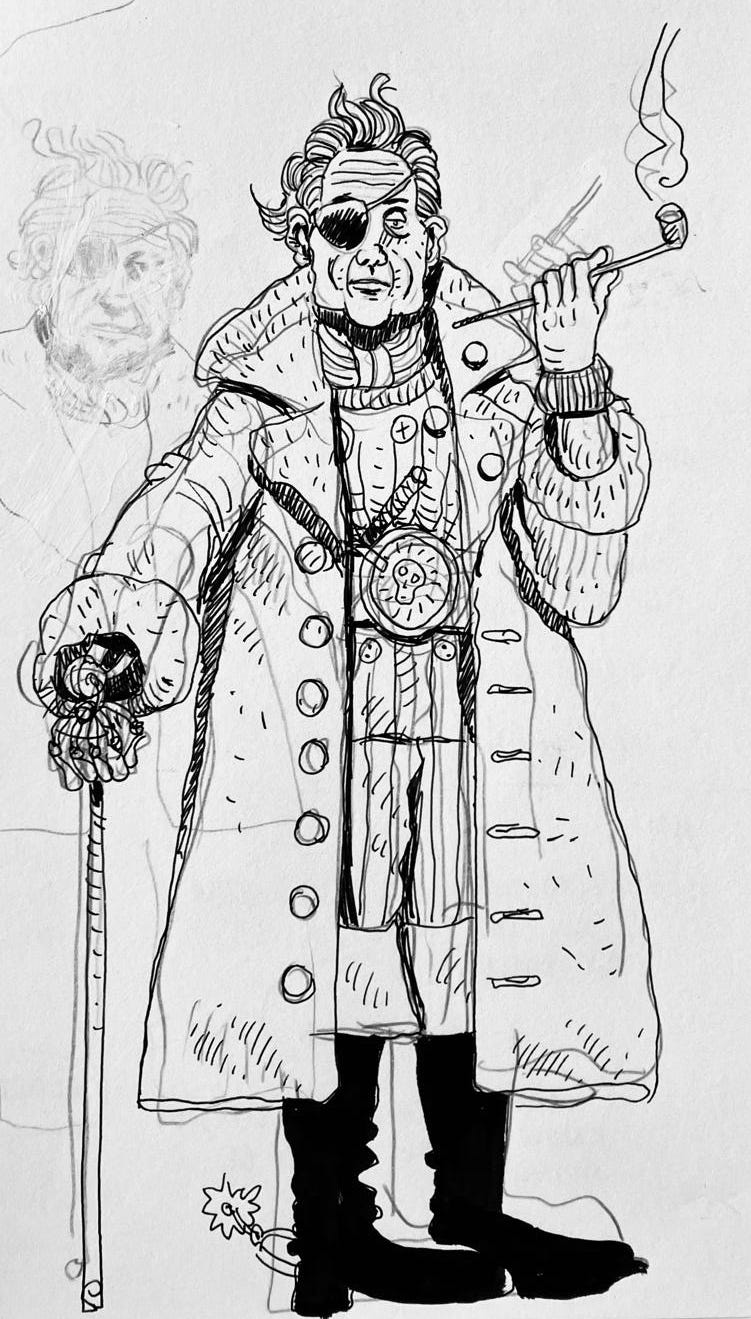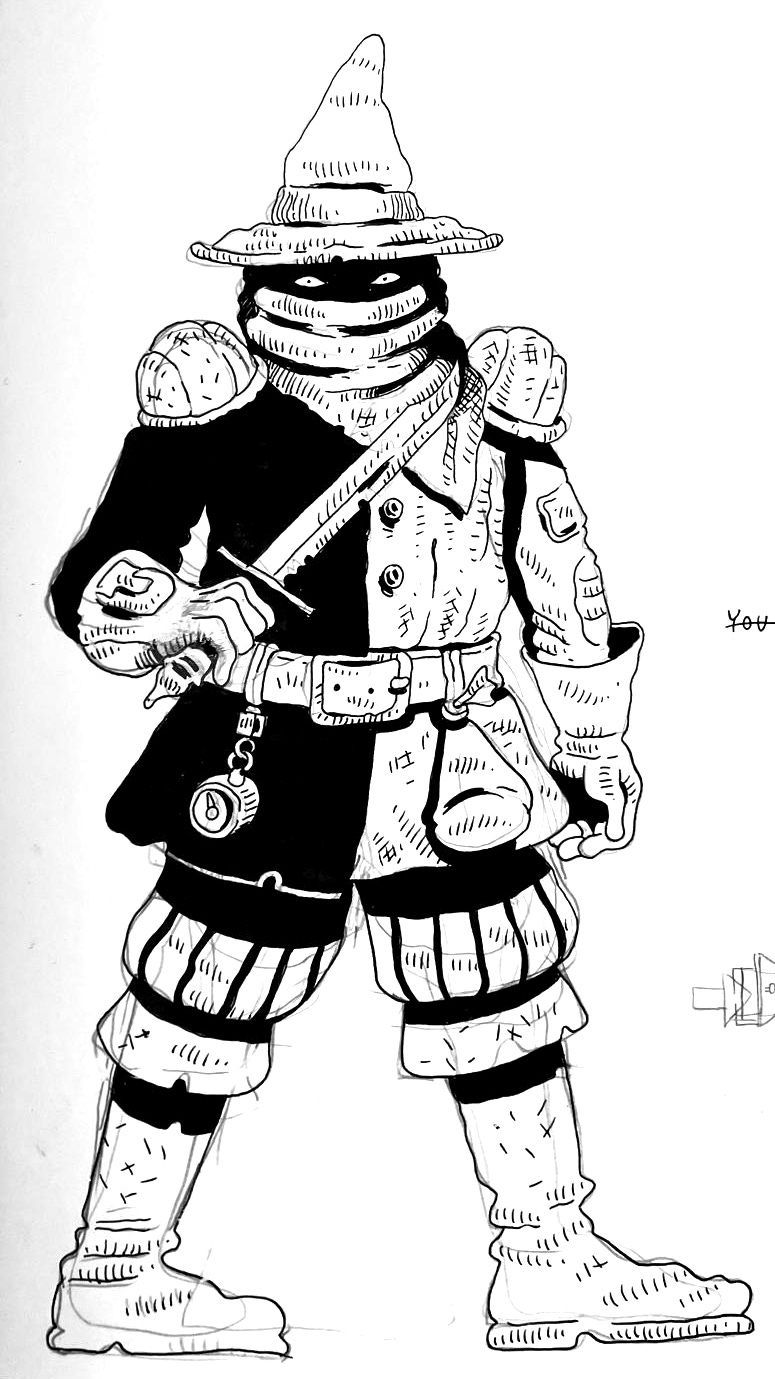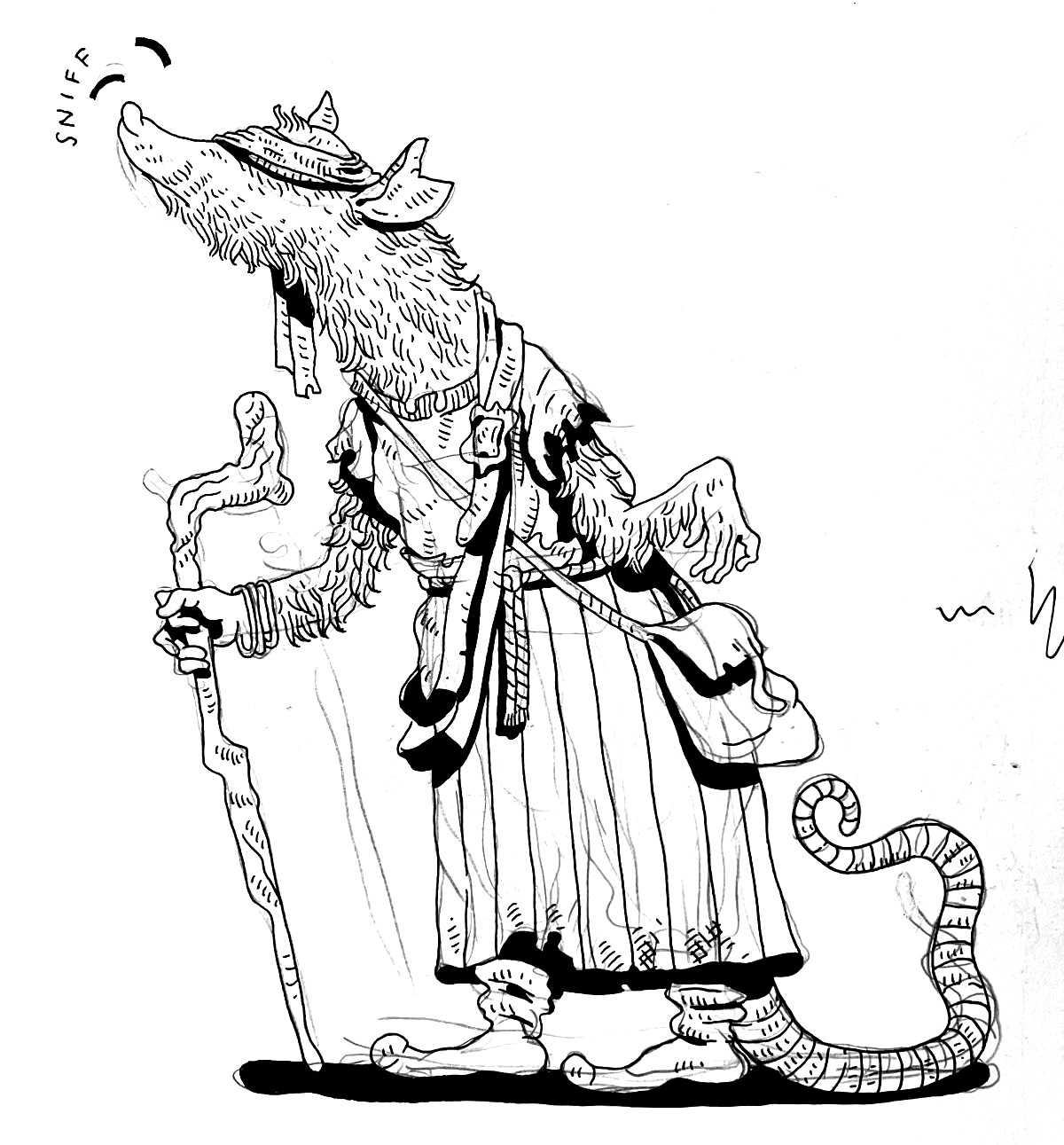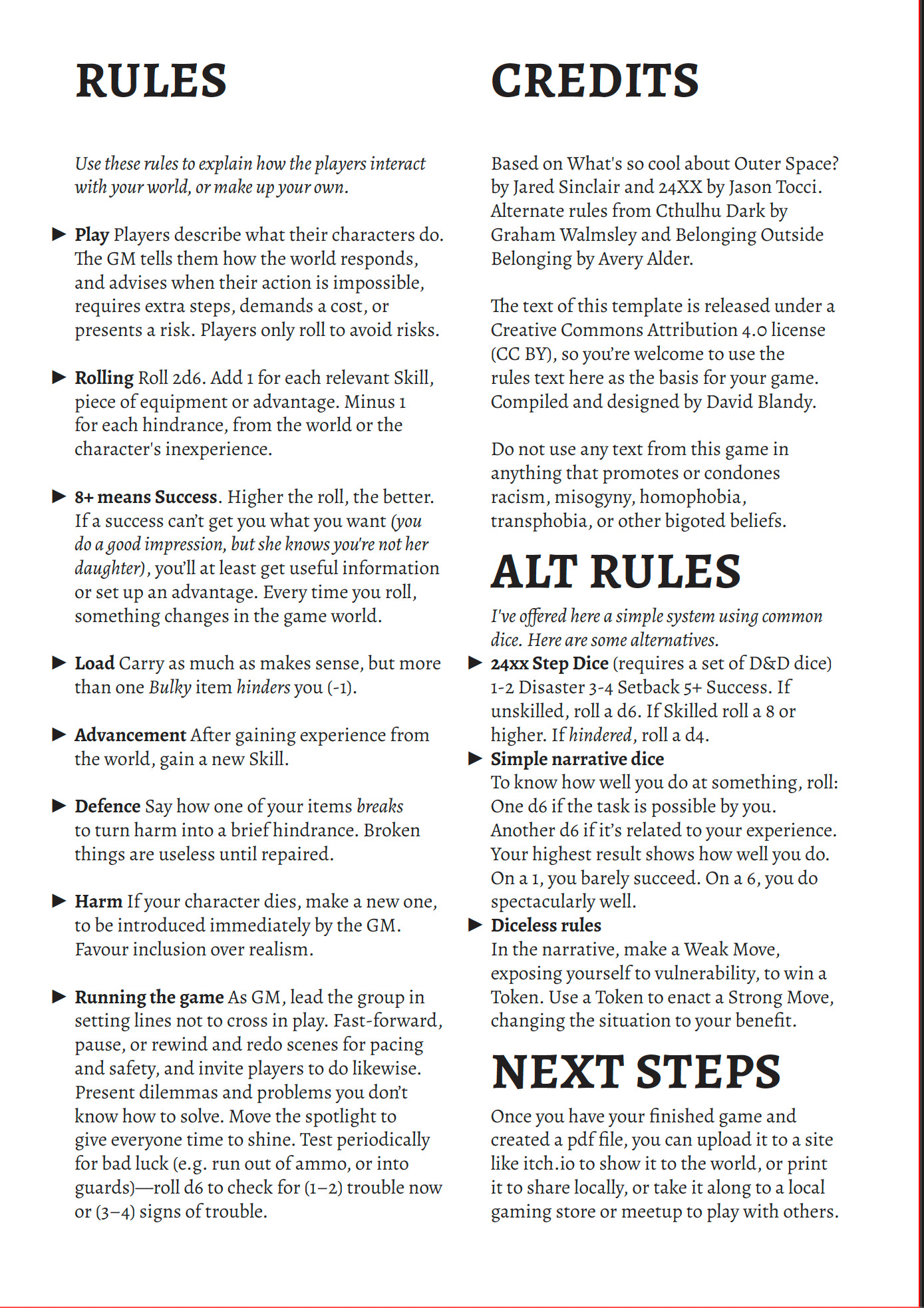It’s probably never been easier to make a TTRPG. There’s such a plethora of resources, advice and SRDs (System Reference Documents) available, each giving a framework to make a game that works that you can adapt for your vision. But I thought I’d give a little insight into my process for getting things going. Because the hardest thing is to actually start.
(Sketch by Daniel Locke)
How to make a TTRPG
There are as many ways to get started as there are types of TTRPGs, but I’m going to take you through how to make a rules-light standard D&D-type game with a GM/DM/Referee and 2-5 players using a little SRD I put together a while ago. It’s based on a few other (excellent) SRDs, particularly Jason Tocci’s 24XX, a document that continues to inspire me with its simplicity and design advice.
I thought I’d start by going the “art-first” route- to take some art that I have access to, and base the game on that, rather than the more usual other way around. This has several advantages. It’s fun, you know for certain the art will be good, and you can really riff off the detail in the images. Babel was made this way, as was Laurie O’Connel’s Hieronymus. Take some art that says something to you (from a permissive Patreon [like Evlyn Moreau’s] or Public Domain [here’s Yochai Gal’s fine collection to rifle through]) and use that as the core of your new game.
Dan, my fellow-passenger at Copy/Paste, just sent me a bunch of sketches, so I’m going to use those for this example.
Setting
The first thing the SRD helps you to do is to create a setting. Not so much “how many continents are there”, more what does it feel like, what kind of world are the players going to play in. It does this through asking you to roll to answer 8 different questions -
What is it? (terrain)
When is it? (Time period)
Who lives here? (PC characters)
What is beautiful? (Why live here?)
What is difficult? (A complication)
Where is adventure? (Where is dangerous yet exciting?)
What is dominant? (A quirk of culture)
What is hoped for? (What could PCs strive towards)
So looking at Dan’s drawing, I’m drawn to combining Wide Ocean (they look a bit piratey) and salvaged junk (there’s a patchwork quality to them). The Time period goes from the beginning of time all the way through to the very end, but I think this is in the near future, the Time of Change. The people are humans, maybe slightly altered, and the community is what’s beautiful. Or maybe the wide open sky. Both is fine.
Greed is what’s difficult, people not sharing as they could, stealing off each other or exploiting each other, and the adventure happens at sea. I’m not sure what’s dominant, so I’ll roll. A 12. A Beast. Maybe there’s a great beast in the sea that means that only small adventurous crews can cross the oceans- if a craft is too big it just gets consumed. I like that. But what is hoped for? 2. A new beginning. So maybe everyone’s looking for something that will kickstart a change, maybe a way to work with this beast in the deep, or a way to satiate them. Maybe some even want to kill them. I can see factions working that way, relating to this overwhelming power in the world in different ways, some worshiping the beast while others revile it, seeking its destruction. And maybe a third group wants to control the beast, use them for their own ends.
So it’s essentially a game of salvage-pirates and mega-monsters. Sounds good to me.
I designed the whole SRD so that everything can be played with just a d6, to make it super-accessible. The full set of polyhedrals is really fun to play with and design for, but not everyone has access to them. A six-sided die is a part of so many games, from backgammon to monopoly, so most people have at least one in their house. Which is why the default system in included in this is 2d6, rolling to reach a target number (8 or over), adding one to your roll for every Skill, piece of equipment or advantage (I’d like to tell previous me to add in the caveat “up to a maximum of +3” to put a limit on player’s adding infinite bonuses shenanigans. Maybe I’ll update the pdf).
Roles
So, we have a setting. Great. But how to players actually interact with this world, and what do they do? This is the fundamental question of game design I think. What are the players there for. If your game doesn’t have a clear role for the players, it’s going to be difficult for them to get involved. So the player options must give them a sense of their character’s place in the world, and will inevitably tell them something about the world itself. At the very least the Roles tell the player - this type of role or class exists in this world. A “Peasant” implies an agrarian society, with a feudal system. Having a Peasant class implies a Lord, maybe even Royalty, and the concept of money and wealth. Just as a “Cleric” implies a system of belief- not only that there are Gods but that there is a hierarchical system of worship, and that there is a priestly class, people who’s only job is to minister the will of God/s. I could go on, but that’s another blog, I guess.
So yes, I need to choose at least 3 roles for this game (to give some choice), that say something about the world. It’s adventure at sea, so let’s make them broadly nautical.
(Daniel Locke just can’t stop sketching. A Pirate, maybe?)
Pirate is a cliche, but it’s a powerful one, that gives images of the sea, living on your wits, fighting against authority, and violence. It’s useful to have as an option as it says a lot about the world, that it’s chaotic and unsafe, but also that there’s a form of freedom. Somewhere between a Thief and a Fighter in traditional D&D.
Navigator is more esoteric, but implies that it’s difficult to traverse this world, and implies secret skills or banks of knowledge that only certain people have access to. We could make this a more technical class, like a Ranger, able to track things and way-find, maybe a bit mystical.
Seer is a bit of a wildcard, to imply some sort of magic in the world. Maybe they can communicate with the great Beasts, maybe they can summon elemental forces. It brings mystery and otherworldiy-ness to the setting.
Of the three, I think that most players will move towards Pirate, but giving the other options is important to communicate to the players what else is possible, and what to expect from the game.
So let’s write them up, according to the SRD. I have to give each Role two skills and a few items to paint a picture of their possibilities and proficiencies.
Pirate brawling, climbing cutlass (d6), rope, lantern, bottle of rum
Navigator wayfinding, tracking, sextant, telescope, padded coat (1 Armour), rifle (d6), pipe and weed
Seer divining, atmokinesis, Staff (d6), patchwork cloak (1 armour), cauldron, pot of mushrooms
I tried to add a bit more flavour with each item, a bare-bones characterisation that the player can add to. The skills, in italics, indicate the kinds of things that the characters might be good at. The Pirate is practical and physical, the Navigator more cerebral and concerning logistics, and the Seer can do weird stuff. I try to keep everything in everyday language, but adding the more esoteric divining and even more unusual atmokinesis seemed important to add flavour to both the character role and the world.
Origins
(Another fine sketch by Daniel Locke)
This is a way to both spice up options, creating more individuality, and also introduce major factions in the setting. I’m going to introduce three: Sea Dog, Mermon, Human. Sea Dog was a term I thought of when brainstorming the Pirate Role, and it just made me laugh when I thought about it literally, so I put it aside for Origins. Then I saw Dan’s image and thought, hmm, Sea Rat. Great swimmer, can maybe communicate with other animals, bit of a weird prankster.
The Mermon is from Eco mofos, and is a mer-person like Kevin Costner’s character in Waterworld- Gills, webbed hands, that kind of stuff. Human is the vanilla, but representative of the dominant culture. Maybe the best in human social situations, good at trading, persuading. But we could go with Landlubber to give it some flavour.
So to write it up, with skills-
Sea Rat swimming, acrobatics
Mermon diving, underwater breathing
Landlubber trading, charming
That’s a good starting point. Maybe a list of setting specific names would be useful to set the scene some more. But we’re going to skip ahead to Jobs/Quests/Missions. We need to give the GM some tools to create adventure in this world, to give impetus to a session.
Jobs
From the SRD:
Jobs/Quests/Missions/Situations
Make a list of Jobs. Tailor these to your setting and the implied tasks that characters are built to perform. These tasks act as "gameable lore", fragments of stories that hint at a setting, a living place, but also designed for use in play. Here are some archetypes. Use a mix.
Someone needs something
Someone needs a thing from a place.
Deal with an unusual threat
Investigate something strange
Get a thing from a dangerous place
Someone/something has gone missing. It/They were last seen somewhere
This is a chance to actually get some specifics in there, name some places, create some intrigue.
Laila, the Braundale baker, needs a new sail for her windmill from the commune at Greystone.
(A simple fetch quest that encourages the players to sail, explore, find out about the world on the way)
The currents have become strange, out to the East. Supplies aren’t getting through.
(Investigation of a weird phenomenon that’ll get the players involved in some problems).
Zoan, the Engineer, has heard about a powerful energy source that could help the village. They want you to retrieve a power cell from the Dark Tower, 3 days sailing East.
(A journey into the dangerous unknown)
At this point I think I need a map. But that’s something for another blog.
Anyway. If I take all that, the setting, the character options, the missions and copy/paste the rules, I’ve got a workable game.
Why don’t you try making a game for yourself?
There are great resources gathered here:
Diogo Nogueira’s Just Make Shit has just about every resource you would need. And it’s a sentiment I throughly agree with.
Coincidentlally, Graham Walmsley’s Cosmic Dark, one of the inspirations for World Engine, is fundraising right now. Why not check it out.
Also funding is Going Rogue, a great TTRPG of IP-redacted rebellion.
And CBR+PNK: OVERLOAD a rules-lite Cyberpunk oneshot system, based on Forged in the Dark






Great article. It makes me want to go and make a game. Thanks for sharing.
Very good guide. Thanks for writing it.